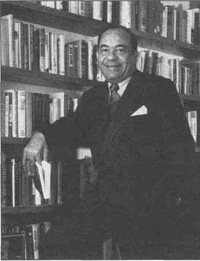 |
Home | Search | Browse | About IPO | Staff | Links |
Book Reviews
Modernist masterpiece set
on Chicago 's south side
By MARIA MOOTRY
Leon Forrest. Divine Days. New York: W.W. Norton, 1992. Pp. 1135. $32 (cloth).
Leon Forrest's Divine Days is a weighty book, in scope, style and size. This is not surprising, given the mission Forrest had accepted when I first met him back in the mid-1970s. He was a new faculty member at Northwestern University in Evanston, and his first novel had just been published.
There Is a Tree More Ancient Than Eden (1973) defied easy categorization. Graced with an elegant introduction by Ralph Ellison, whose 1952 masterpiece Invisible Man had clearly engaged Forrest with its craftsmanship, the novel was pure lyric. Inspired by Ellison's example, Forrest spoke of the necessity for the African-American writer to be willing to "take on" the literary greats like Dostoevsky, Joyce and Faulkner. There Is a Tree More Ancient Than Eden also reflected Forrest's nonliterary role models, who were African-American superstars in other fields: Sugar Ray Robinson in sports, Billie Holiday in music, Romare Bearden in art. By selecting such models and rivals, Forrest made it clear that the African-American creative writer must aspire to rank with the best, in his own tradition and in the world.
In Divine Days, Forrest weds the winsome lyrical narrative voice of his first novel to the fearsome historical resonance of his second and third, The Bloodworth Orphans (1977) and Two Wings To Veil My Face (1984). The addition of a running strain of wit and comedy yields a unique text in the Forrest canon.
Forrest uses the spoken voice with divine delight in Divine Days. One example filled with subtle, zany humor is the scene in which the young narrator is trying to interview the seasoned Reverend Roper. The narrator tells us: "I was glad to consume the head-clearing tea ... don't serve me two Vodka Martinis, I get killer keen and heartless evil." We can almost see him winking. Incidentally, Forrest is an excellent reader of his own work and regularly teaches a course on "The Oral Tradition" at Northwestern.
Like a cunning jazz artist, Forrest riffs brilliantly on the African-American tradition of toasts, jokes, signifying (a tactic for verbal dueling) and other storytelling devices. But this orality also recalls his modernist role models: Joyce and Faulkner. Like them, Forrest aspires to epic, oracular scope. Critic John Cawelti calls Divine Days "the Ulysses of the South Side." Forrest creates his own Faulknerian "little postage stamp of native soil," called — appropriately — Forest County, interiorizes it, dramatizes it, and gives it a dignity and significance worthy of Shakespeare.
|
Forrest's strength, then, lies in his ability to capture what some critics call "cultural narratives." He transforms a sociological poetics into a literary aesthetic, as if deriving fine champagne from a hardy, nourishing beer. In part, Forrest achieves this alchemy by refusing to honor boundaries between kinds of literature as well as among various art forms. Readers of his fiction will be reminded of musical and theatrical models like jazz and oratorio.
Forrest's "Chicagoness" lies in his use of setting and allusions. Divine Days takes place in south side bars, churches and barbershops. The plot's timespan — seven days — reminds us of the meaning ascribed to the number seven in sacred and secular African-American culture. To be the seventh son of a seventh son is to be endowed with special prowess. Numerology is an important part of traditional black folk culture. Within this time frame, Forrest's protagonist, the journalist, playwright and bartender Joubert Jones, tries to absorb, interpret and re-create the rich culture he inhabits while sustaining his own voice and vision. His mentor-friend, Sugar-Groove, is a "library" of knowledge and style that Joubert wants to turn into a play replete with incredibly complex and elusive characters, from the demonic trickster, W.A.D. Ford, to the streetwise Aunt Eloise with her Night Light Lounge. |
|
In the end' Divine Days is a very modernist text that turns on itself. At its conclusion, Joubert scolds St. Peter, who is baffled when he watches Sugar-Groove (now an angel in heaven) take his shabby allotment of patched-up wings and turn it into something dazzling. St. Peter complains, "I can't find the proper words to express the meanings of all your carryings on ... ." Joubert's answer reflects the African-American writer speaking of his craft: "No, St. Peter, you can't.... That's my job."
None of Forrest's novels is easy reading. How could they be? They are fused with his mission to "uncover the weave of history," to evoke a sacred and secular tradition, to capture the dimensions of an aesthetic forged from cultural scraps in a Yeatsian "foul rag and boneshop of the heart." This is no simple task, but then nobody said it would be. Forrest is not for the faint-hearted, but he is richly rewarding. If you can't read Divine Days in its entirety, try it in parts. Better yet, go hear Forrest read from it. Your pleasure will be doubled.
Maria Mootry is the convener of African-American Studies and an associate professor of English at Sangamon State University in Springfield. An interview she conducted with Leon Forrest was published in the anthology Chant of Saints: A Gathering of Afro-Ameri-can Literature, Art and Scholarship (University of Illinois Press, 1979).
April 1994/Illinois lssues/41
|
Sam S. Manivong, Illinois Periodicals Online Coordinator |
